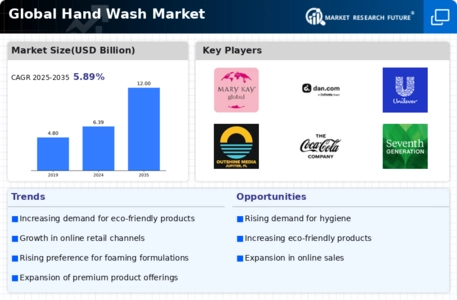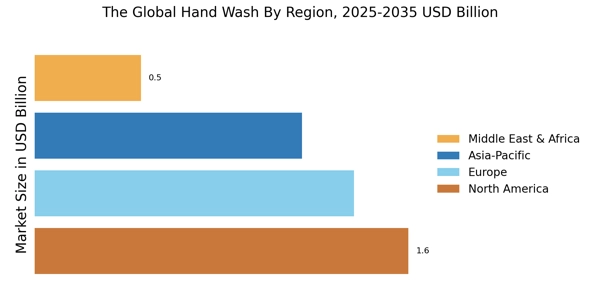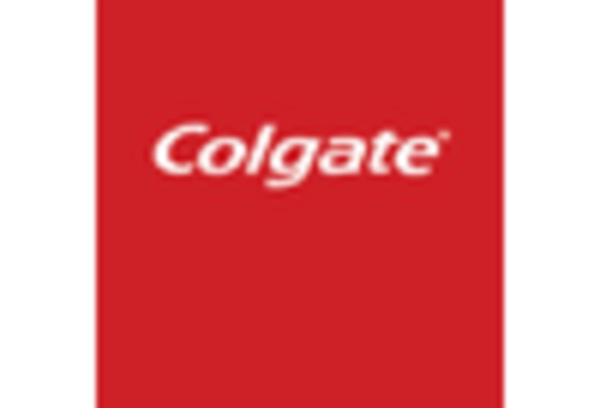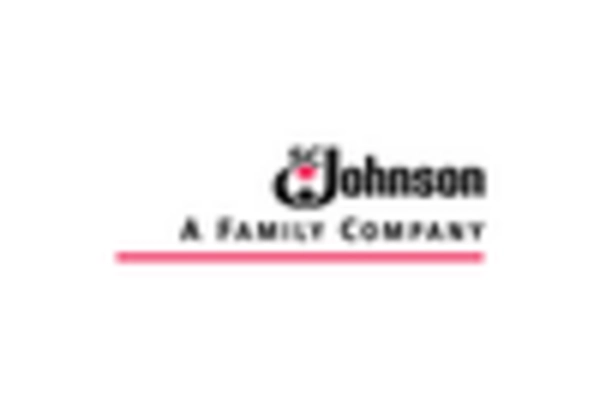Rising Health Awareness
The increasing awareness regarding personal hygiene and health is a pivotal driver for the hand wash market. Consumers are becoming more conscious of the importance of hand hygiene in preventing infections and diseases. This trend is reflected in the rising sales of hand wash products, which have seen a growth rate of approximately 5% annually. The Global Hand Wash Industry is benefiting from this heightened focus on health, as more individuals are incorporating hand washing into their daily routines. Furthermore, educational campaigns by health organizations are reinforcing the significance of hand hygiene, thereby propelling demand for hand wash products. As a result, manufacturers are innovating to create products that cater to this health-conscious demographic, leading to a diverse range of offerings in the market.
Increased Retail Availability
The expansion of retail channels is significantly influencing the hand wash market. With the rise of supermarkets, hypermarkets, and online platforms, consumers have greater access to a variety of hand wash products. The Global Hand Wash Industry is experiencing a shift as e-commerce sales continue to grow, accounting for a notable percentage of total sales. This increased availability allows consumers to choose from a wider range of brands and formulations, catering to diverse preferences. Retailers are also promoting hand wash products through strategic marketing campaigns, further driving sales. As a result, the competitive landscape is evolving, with brands striving to enhance their visibility and availability in both physical and digital retail spaces.
Innovative Product Development
Innovation in product formulation and packaging is a key driver in the hand wash market. Companies are increasingly investing in research and development to create unique products that meet consumer preferences. For instance, the introduction of natural and organic hand washes has gained traction, appealing to environmentally conscious consumers. The Global Hand Wash Industry is witnessing a surge in demand for products that are free from harmful chemicals and are biodegradable. Additionally, advancements in packaging, such as pump dispensers and travel-friendly sizes, enhance user convenience and encourage frequent use. This focus on innovation not only attracts new customers but also retains existing ones, as consumers are drawn to brands that offer novel and effective solutions for hand hygiene.
Growing Demand for Eco-Friendly Products
The shift towards sustainability is driving demand for eco-friendly hand wash products. Consumers are increasingly seeking products that are not only effective but also environmentally responsible. The Global Hand Wash Industry is responding to this trend by offering biodegradable and sustainably sourced ingredients in their formulations. This demand for eco-friendly options is reflected in market data, indicating a rise in sales of natural hand washes. Brands that emphasize their commitment to sustainability are likely to attract a loyal customer base, as consumers are more inclined to support companies that align with their values. This growing preference for eco-friendly products is expected to shape the future of the hand wash market, as manufacturers innovate to meet these evolving consumer expectations.
Regulatory Support for Hygiene Practices
Government regulations and guidelines promoting hygiene practices are a crucial driver for the hand wash market. Many countries are implementing policies that encourage the use of hand hygiene products in public spaces, schools, and healthcare facilities. The Global Hand Wash Industry is benefiting from these regulatory frameworks, which not only raise awareness but also create a consistent demand for hand wash products. Compliance with hygiene standards is becoming mandatory in various sectors, leading to increased procurement of hand wash solutions. This regulatory support is likely to sustain market growth, as organizations and institutions prioritize hygiene to ensure public health and safety. Consequently, manufacturers are aligning their product offerings with these regulations to capture market opportunities.


















Leave a Comment